A Swing Around Kolkata on Christmas Day
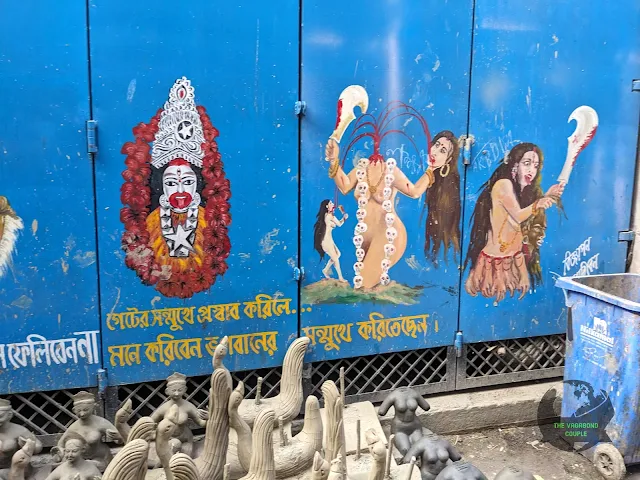 |
| Sign at Kumartuli, Kolkata roughly translates to "no nuisance in front of the goddess (Kali)" |
We reach Kolkata on the morning of December 24 after almost two full days of travel that started with a drive from our home in Washington, DC to New York's JFK to catch Kuwait Airlines' Dreamliners to New Delhi via Kuwait City followed by a Vistara Airlines A320-neo connecting to Kolkata.
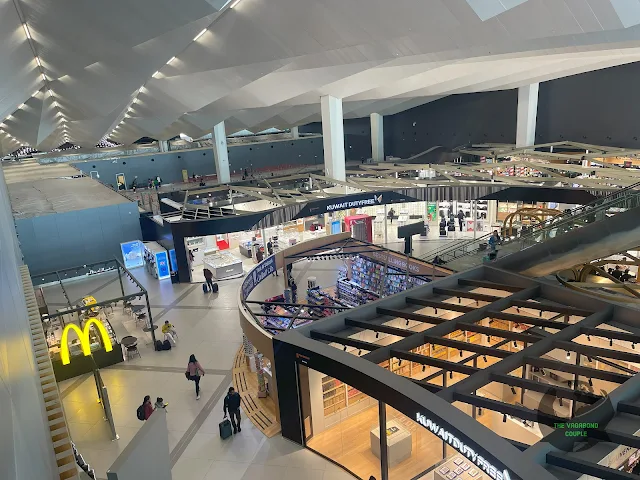 |
| Kuwait City Airport |
I spent just 13 years of my life in our house in Salt Lake, Kolkata, but these 13 years crucially covered my childhood from 4th grade through attainment of a Masters degree that let me set sail into the bigger world. Now Ma lives by herself here and I had come visiting with her grandchildren and a friend of my daughter. Curiously, it was the children who had expressed a desire to come spend time with Thammi!
 |
| Our house in Salt Lake, Kolkata |
Here is thammi trying out a jacket we got for her from Maryland. It turns out this jacket is totally inappropriate for non-existent winters of Kolkata. However, it will come in useful in Agra and subsequently the great Thar desert of Rajasthan which we are headed to in two days.
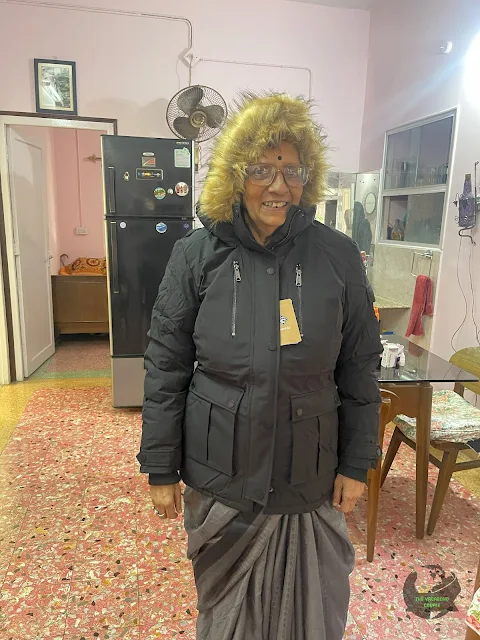 |
| Thammi tries her new jacket on |
The paanwala below "3 No. Tank" still runs his paan shop exactly the same way for at least two decades now. He does make excellent mishti paan, no question.
 |
| Paan shop, 3 No. Tank, Salt Lake |
In the evening, we walk the half a block to "Momo I Am" to have a sumptuous dinner of authentic Tibetan momo and thukpa noodle soup. The bill for five people stuffing themselves full with pure deliciousness? Around $30!
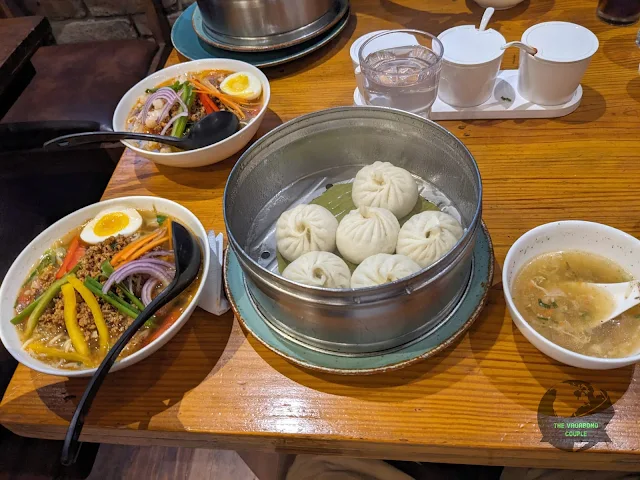 |
| Momo and Thukpa at "Momo I Am" at Salt Lake |
The wall decor of the restaurant reflects the general intellectual sophistication of the city.
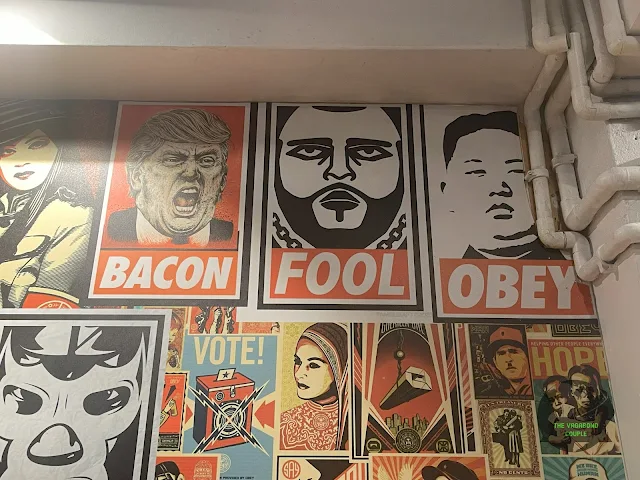 |
| Wall decor at "Momo I Am" |
After dinner, Ma walks back home while the rest of us walk a few steps into the Salt Lake City Center Mall which is all decked up for Christmas.
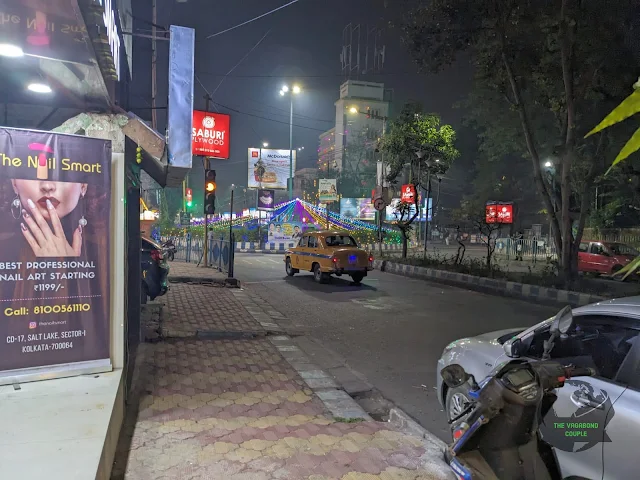 |
| 2nd Cross Road, Salt Lake towards City Center Mall to the right of the traffic circle ahead |
 |
| Salt Lake City Center Mall |
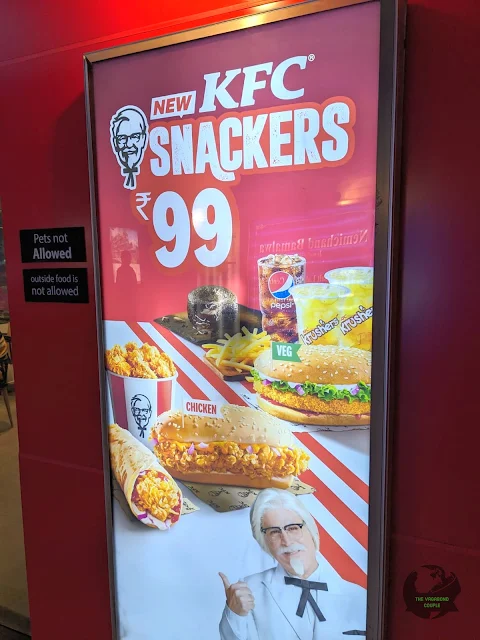 |
| KFC, Salt Lake City Center |
With the influx of cheap Chinese battery powered totos, human-powered rickshaws of the Kolkata of my childhood are few and far between now. The classic old yellow Ambassador taxis are still very much around, though.
 |
| Toto (Battery-powered rickshaw) |
It is christmas day next morning. We hop into a Toyota Innova minivan early in the morning to drive around the city. Kolkata gets insanely crowded on christmas and we are fully aware of the impossibility of actually getting into major tourist attractions. To make the endeavour as easy as possible given our severely jet-lagged state, we enlist the services of Quick-O-City who provide a driver for the minivan and our English-speaking guide Subrata who does a great job of explaining what the kids are looking at.
We drive past the famous Salt Lake Stadium on our way out of the Salt Lake neighborhood. Known officially as the "Yuvabharati Krirangan" (Indian Youth Stadium), its three tiers of concrete rise like the stands of an ancient Roman amphitheater. With a seating capacity of 80,000, it once held the title of the world's second-largest stadium, a testament to Kolkata's undying love for football ("soccer" to yanks).
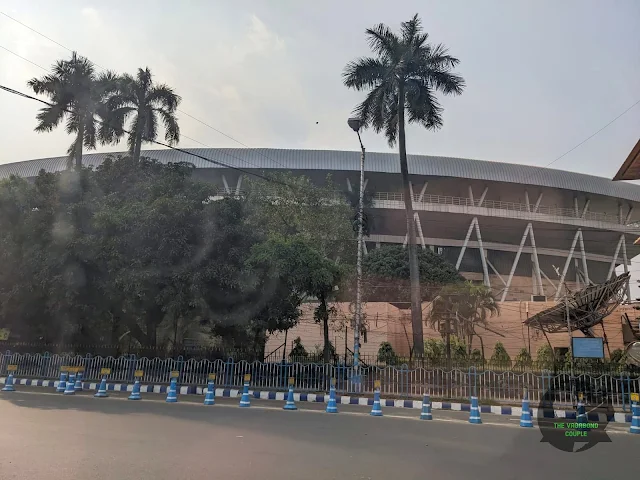 |
| Salt Lake Stadium, Kolkata (Yuvabharati Krirangan) |
This stadium is where legendary Kolkata derbies between Mohun Bagan and East Bengal clubs unfold, where fans paint the stands in a sea of red and green, their devotion as fierce as the tackles on the field. It has also hosted cricket matches, athletics championships and cultural events. The 2017 FIFA U-17 World Cup saw the stadium bathed in international glory proving its mettle as a world-class sporting venue.
As we head into downtown Kolkata over new highways and flyovers like the "Maa Flyover" that did not exist when I left the city, we cross some modern-looking buildings. The ITC Royal Bengal Hotel, for example, went into operation in 2019. Expedia says standard rooms there with queen beds are still pretty affordable by international luxury standards at under $150/night.
 |
| ITC Royal Bengal Hotel |
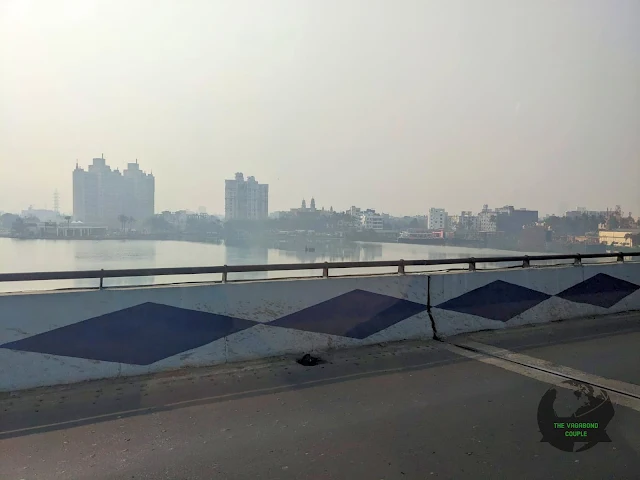 |
| Residential towers as seen from Maa flyover |
Driving on Acharya Prafulla Chandra Road, we see one of the hand-pulled rickshaws still in service in Kolkata. These hand-pulled rickshaws are a unique and iconic feature of the City of Joy. The two-wheeled carriages, pulled by human power, have been a part of Kolkata's landscape for over a century, a legacy of the colonial era.
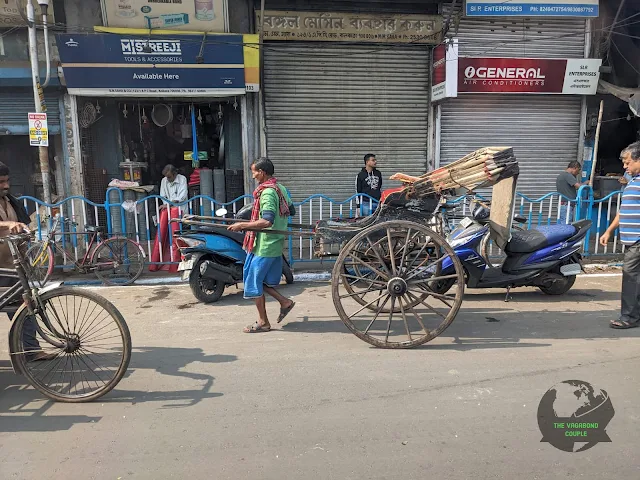 |
| Hand-pulled rickshaw |
Introduced by the British in the late 19th century, these rickshaws were originally seen as a symbol of colonial power and privilege. Wealthy Europeans used them to get around the city while poor Indians were often forced to pull them. In the post-colonial era, however, rickshaws became a more egalitarian mode of transportation used by people of all classes. Today, rickshaw pulling is a vital source of income for many Kolkatans, especially those who come from marginalized communities. There are an estimated 18,000 rickshaw pullers in Kolkata, serving over 10 million people every year. Despite the challenges of the job such as long hours, low wages and exposure to the elements, rickshaw pulling remains an important part of the city's economy.
We drive across College Street which still is a haven for book lovers with rows and rows of stalls selling new and used books on every subject imaginable.
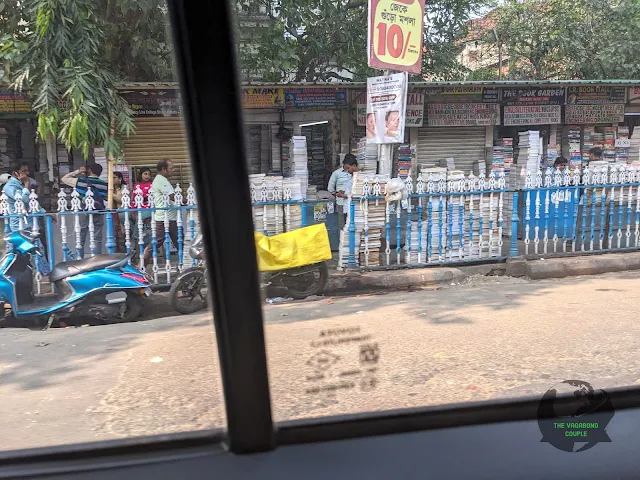 |
| College Street book stalls |
Our first stop in the city, particularly poignant on christmas, is the humble abode of Mother Teresa. The house also is the international headquarters of the Missionaries of Charity. Among the globally most recognized people associated with Kolkata, Mother Teresa of Albanian descent was born in 1910 in Skopje, North Macedonia.
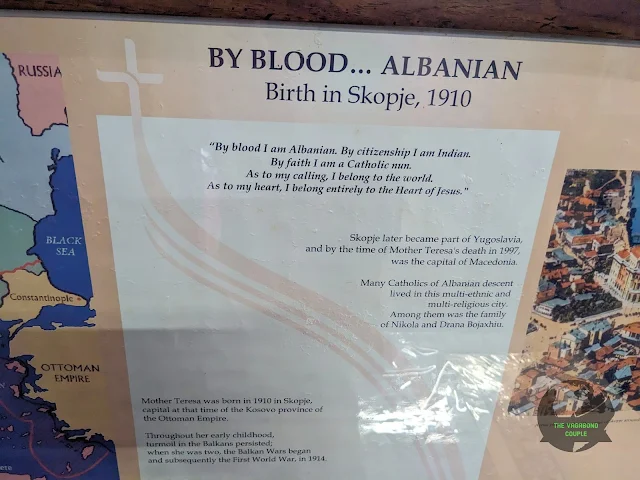 |
| An information board inside Mother House |
After a short stint with Institute of the Blessed Virgin Mary Loreto Sisters in Ireland, Mother Teresa heeded her strong inner calling to serve the needy in Kolkata starting in 1950. She subsequently purchased a dilapidated building at 54A, AJC Bose Road in 1952. This became the Mother House, a haven for the poorest of the poor, the sick, and the dying. From its humble beginnings, the Missionaries of Charity grew into a global organization now serving the marginalized in over 130 countries. Mother Teresa was canonized into Sainthood on Sunday September 4, 2016.
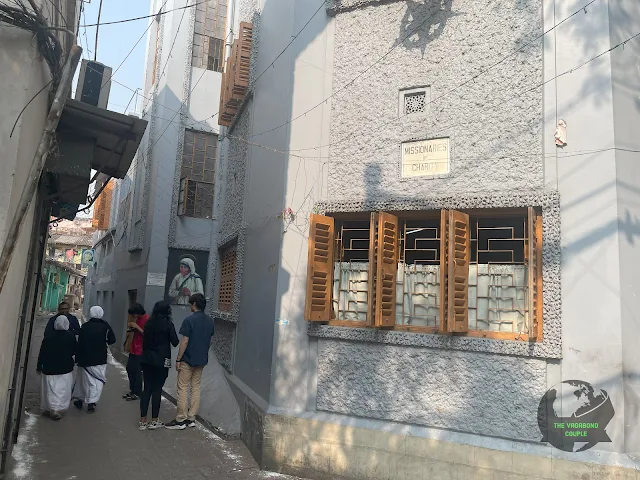 |
| Mother House: Mother Teresa's Home / Missionaries of Charity |
Visitors to Mother House are greeted by a serene courtyard where a simple cross stands as a symbol of faith and sacrifice. The ground floor houses a small museum showcasing Mother Teresa's life and work with photographs, letters and personal belongings. Mother Teresa's own room, preserved as it was on the night of her passing in 1997, is incredibly spartan with a bare metal bed, a simple desk and a few religious icons. It speaks volumes about her commitment to a life of simplicity and service.
Beyond the museum, the Mother House is a functioning convent and home to the Missionaries of Charity sisters. Visitors can attend daily prayers in the chapel, a space filled with quiet devotion. The atmosphere is one of peace and reflection, a stark contrast to the chaos of the city outside.
Mother Teresa's tomb is located on the ground floor of the main building of the Mother House.
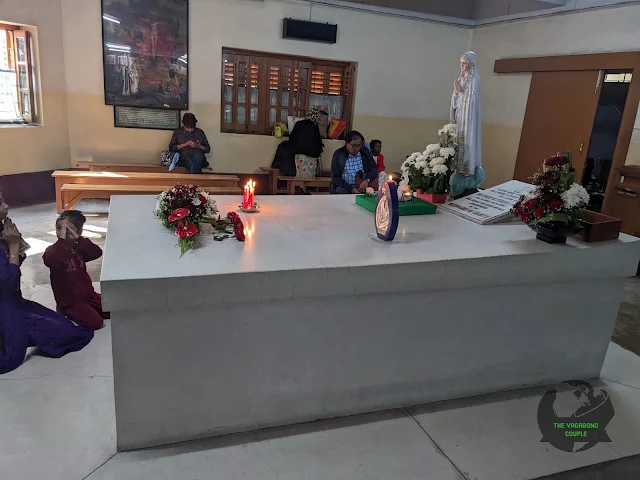 |
| Mother Teresa's Tomb in the Mother House |
Today, the Mother House continues to be a beacon of hope for the underprivileged. The Missionaries of Charity run a home for the dying destitutes, a children's home, a leper colony and a school, all within walking distance of the Mother House. These institutions carry on Mother Teresa's legacy of serving the poorest of the poor with compassion and dignity. We saw sisters of the Missionary and volunteers taking residents of the charity on assisted walks.
 |
| Mother House: Mother Teresa's Home / Missionaries of Charity |
After paying homage to the great saint, we drive towards Flurys at 18A Park Street (officially renamed to "Mother Teresa Sarani") with the hope of tasting their world-famous English breakfast. Park Street is famous for its light decoration on christmas. We see lamps strung across that will transform Park Street at sunset.
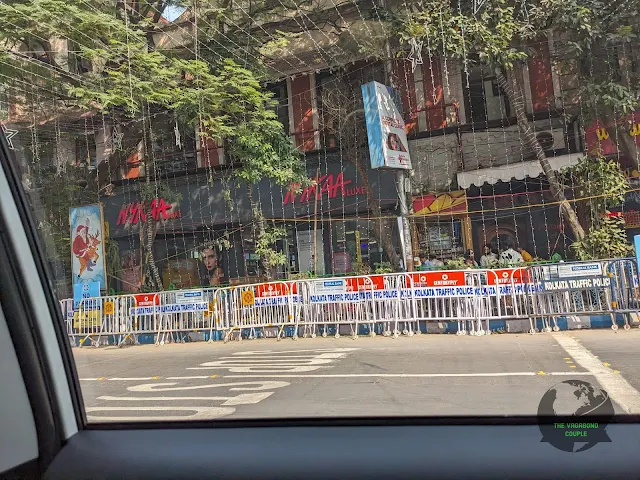 |
| Christmas lights strung across Park Street |
Unfortunately, the ridiculous wait time at Flurys ruled out a breakfast there and we had to settle for a cafe across the street. Alas - if only we had the sense to reserve a table in advance!
 |
| Queue for breakfast at Flurys on Christmas Day |
Our next stop is the Parshwanath Jain Shwetamber Temple, often simply called the Jain Temple of Kolkata or the Shwetamber Jain Temple, at Badridas Temple Street, Gouribari in the Maniktala neighborhood near Khanna/Shyam Bazar. This spectacular temple is a tribute to the Jain faith and heritage in the heart of Kolkata. Its beginnings date back to 1867 when philanthropist Ray Badridas Bahadur Mookim envisioned a temple dedicated to Lord Parshwanath, the 23rd Jain Tirthankara. Construction commenced and within a few years the temple's intricate architecture and serene ambiance brought it to prominence.
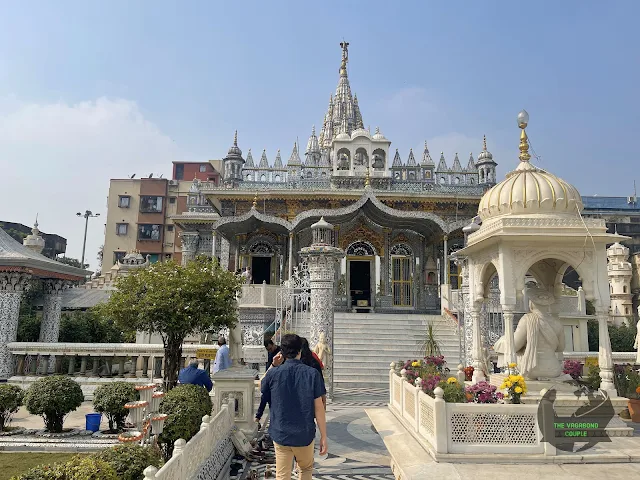 |
| Parshwanath Jain Shwetamber Temple |
The Parshwanath Jain Temple embodies the core principles of Jainism: non-violence (ahimsa), compassion and simplicity. The temple's serene atmosphere encourages introspection and spiritual growth, offering solace to many.
 |
| Parshwanath Jain Shwetamber Temple |
The temple is a harmonious complex of four temples, each holding its own unique charm:
- Shitalnath Ji Temple: The main shrine houses the idol of Lord Shitalnathji, the tenth Tirthankara, adorned with a dazzling diamond-studded forehead.
- Chandraprabhu Ji Temple: Dedicated to Lord Chandraprabhuji, the eighth Tirthankara, this temple showcases intricate marble carvings and vibrant paintings.
- Mahavir Swami Temple: Revered as the last Tirthankara, Lord Mahavira (6th century BCE) finds his place in this temple, adorned with exquisite chandeliers and glasswork.
- Dadawadi and Kushal Maharaj Temple: This temple holds a revered footprint of Jain Acharya Jin Dutt Kushal Suri, symbolizing his spiritual guidance.
The architectural style of the Parshwanath Jain Temple is a captivating blend of Jain, Hindu and European influences. Ornate pillars, sculpted figures and stained glass windows create a visual symphony, while marble flooring and intricate floral designs lend a touch of elegance.
Open to people of all faiths, the temple fosters inclusivity and understanding. Visitors can witness daily prayers, participate in religious ceremonies, or simply bask in the tranquility of the sacred space.
 |
| Gardens of Parshwanath Jain Shwetamber Temple |
Reflecting the Jain commitment to social welfare and education, the temple complex also houses a library, a school and a charitable hospital. These initiatives serve the underprivileged and contribute to the well-being of the community.
The Sree Sree Thakur Anukul Chandra Satsang Mandir is across from the Parasnath Mandir Jain Temple. Thakur Anukul Chandra Satsang, established in 1920, has become a beacon for those seeking inner peace and guidance. Founded by Thakur Anukul Chandra himself, the Satsang emphasizes self-realization and liberation through a unique blend of spiritual practices and teachings. The core principle of "Jibanmukti," attaining liberation while living, remains central to the Satsang's philosophy. The organization actively promotes social welfare and humanitarian activities, reaching out to underprivileged communities.
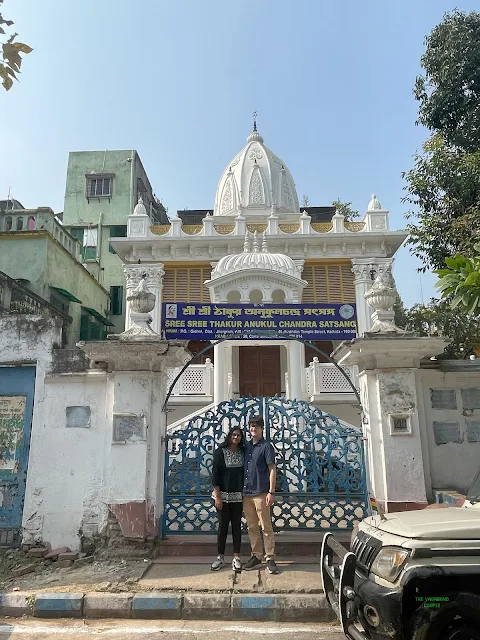 |
| Sree Sree Thakur Anukul Chandra Satsang Mandir |
This grand temple complex serves as the Satsang's headquarters. The intricate marble architecture and serene atmosphere create a space for introspection and prayer. Daily rituals, kirtan sessions, and satsangs draw devotees from all walks of life. There is also a Sri Sri Thakur Anukul Chandra Satsang Bhavan in Dum Dum which is an ashram offering a tranquil retreat for spiritual seekers.
Leaving the temples, we head to the Shobhabazar neighborhood next and visit the grand old bazaar and fish market there.
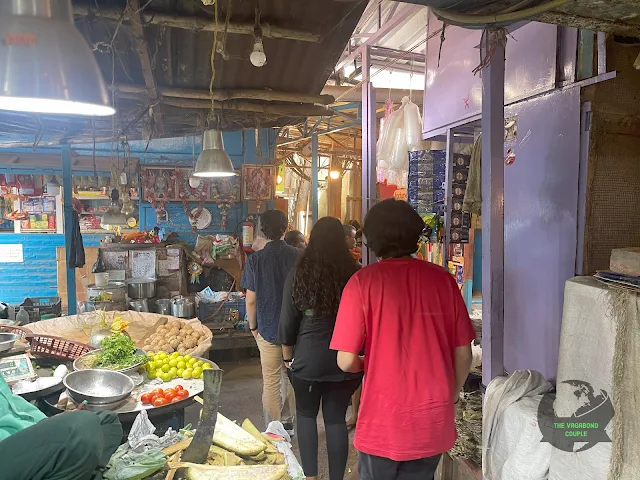 |
| Shobhabazar |
Nestled in Kolkata's heart, Shobhabajar bazaar hums with a vibrant chaos. Winding lanes crammed with stalls stacked high with vegetables, fruits, spices, silks and utensils lead to the beating heart - the fish market. There are Bengali sweet shops offering truly an experience for the senses, from the melt-in-your-mouth texture of sandesh to the syrupy goodness of rosogolla.
 |
| A Sweet Shop, Shobhabajar |
 |
| Vegetable stall, Shobhabajar |
Hawkers shout their wares – mounds of saffron spices jostle for space with shimmering silk saris, the clanging of metal from utensil shops mingling with the melodic twang of sitar strings. The sweet, pungent aroma of street food mingles with the earthy fragrance of incense wafting from temple doors, creating a unique olfactory symphony.
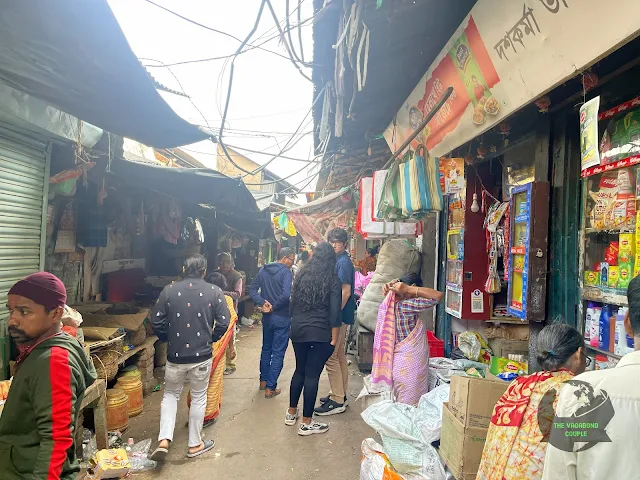 |
| Shobhabajar |
Sunlight slices through the corrugated roof, glinting off scales of iridescent hilsa and plump prawns. The air ripples with a salty tang punctuated by the cries of vendors hawking their catch. Catfish whiskers twitch, eels squirm in buckets, and eyes of pomfret stare impassively.
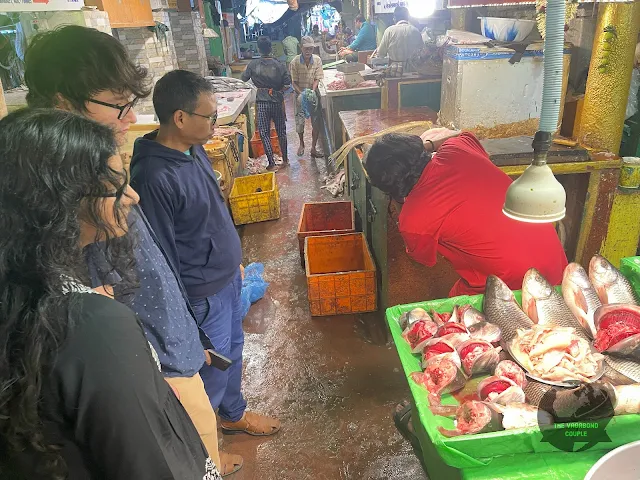 |
| Shobha Bazar Fish Market |
Bargaining mingles with banter, creating a symphony of haggling as nimble hands fillet and scale, preparing aquatic treasures for Bengali dinner tables. In Shobhabajar, the pulse of Kolkata's culinary spirit finds its rhythm in the dance of fish and fisherman.
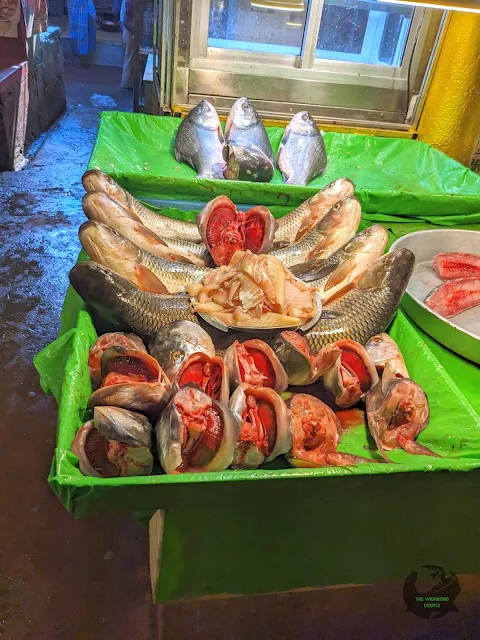 |
| Shobhabajar Fish Market |
Walking along Rabindra Sarani, we catch a glimpse of the Rameshwar Shiva Temple. One of the oldest temples of the city, this timeworn temple tucked away in the bustling lanes of Shobhabajar dates back to the 18th century. It exudes a timeless elegance with its terracotta facade adorned with intricate carvings. Towering above the surrounding buildings, the shikhara (spire) of the temple pierces the sky.
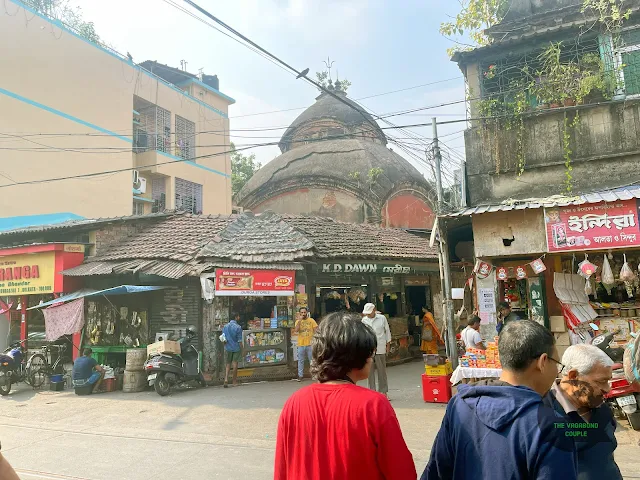 |
| Rameshwar Shiva Temple |
We walk past Nandaram Sen street taking in the kaleidoscope of senses of Shobhabajar. The narrow lanes, often choked with the rhythmic honking of hand-pulled rickshaws, weave past centuries-old mansions with intricate terracotta facades, their balconies adorned with overflowing blooms.
 |
| Rabindra Sarani & Nandaram Sen St |
We jaywalk across Rabindra Sarani in pure Kolkata style with the chaotic traffic flowing smoothly around us into Abhay Mitra Street towards Kumartuli.
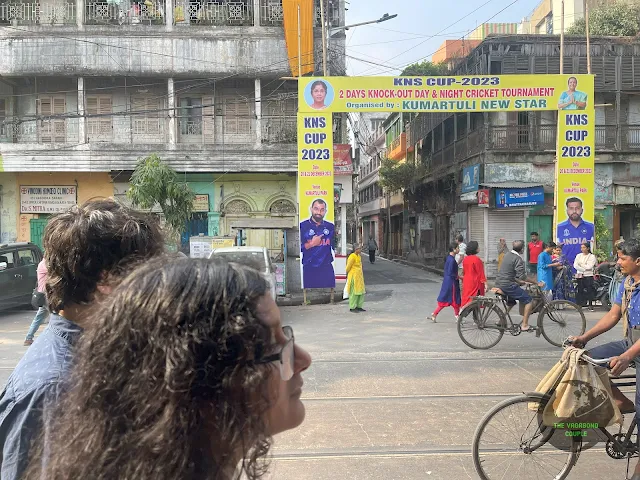 |
| Rabindra Sarani & Abhay Mitra Street |
Kumartuli, a narrow labyrinth nestled in north Kolkata, isn't just a neighborhood – it's a living, breathing testament to the city's artistic spirit. Walking down its dusty lanes past ramshackle workshops draped in clay dust, the air vibrates with the rhythmic thwack of chisels and the earthy scent of wet clay.
 |
| Kumartuli |
Here, generations of artisans breathe life into shapeless mounds, transforming them into divine beings destined to grace pandals during Kolkata's most celebrated festival, Durga Puja, as well as the numerous other Pujas of Bengal including Saraswati Puja, Lakshmi Puja, Biswakarma Puja and so on.
 |
| A mound of clay at Kumartuli awaiting magical transformation |
We are visiting Kumartuli just in time for Puja organizers beginning to place orders for idols of Goddess Saraswati before the looming Saraswati Puja.
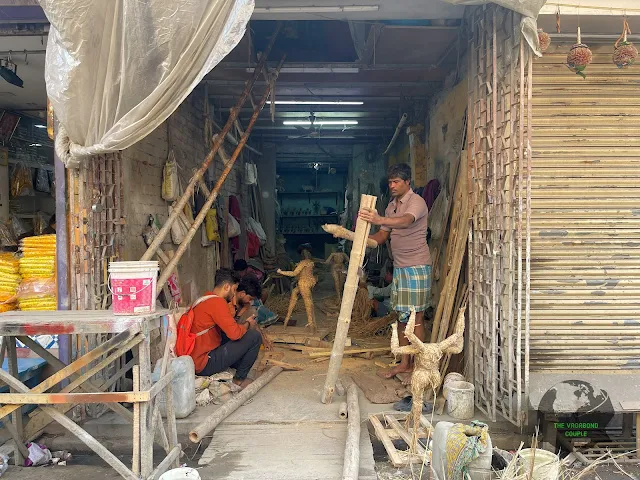 |
| Clay taking the shape of Ma Saraswati in Kumartuli |
Saraswati, the Goddess of knowledge, music and arts, is adorned with four exquisite hands, each holding a symbolic object that unveils a facet of her divine power. In one hand, she cradles a book. Not just any book, but a sacred scripture representing the boundless ocean of knowledge, both worldly and spiritual. It whispers of ancient wisdom, ignites creative sparks, and guides seekers on their path to enlightenment. In another hand, she gracefully plucks the strings of a Veena. This stringed instrument resonates with the melody of life itself. Every strum represents the rhythm of creation, the flow of language, and the harmony of thought and feeling. Her music inspires artistic expression, soothes troubled souls, and elevates the spirit. A rosary of white pearls graces a third hand. Each pearl whispers a mantra, a syllable of wisdom, a chant that unlocks the power of speech and intellect. It symbolizes clear communication, focused thought, and the ability to articulate truth and knowledge. The final hand, often outstretched in blessing, holds a water pot. This pot brims with the nectar of life, the essence of creativity and inspiration. It signifies the source of all arts, the flow of ideas, and the nourishment that feeds the mind and soul.
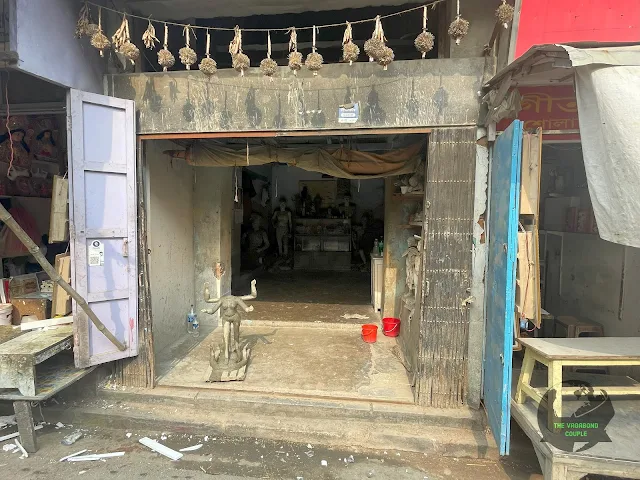 |
| Saraswati idol in progress at Kumartuli |
Together, her four hands paint a mesmerizing portrait of Saraswati's divine essence. They embody the power of knowledge, the magic of creation, the clarity of wisdom, and the blessings of inspiration. They offer guidance to students, poets, musicians, and artists, beckoning them to embrace their potential and unleash their creative spirit.
Within these humble workshops of Kumartuli, magic unfolds. Calloused hands mold clay with practiced ease, coaxing intricate features onto the faces of gods and goddesses.
 |
| Artisans at work, Kumartuli |
Sunlight streams through gaps in corrugated roofs, illuminating a mesmerizing ballet of creation. Eyes, sharp and focused, peer from beneath straw hats, meticulously adding details – a curve of the lip, the flutter of an eyelash, the fierce glint of a warrior goddess's gaze.
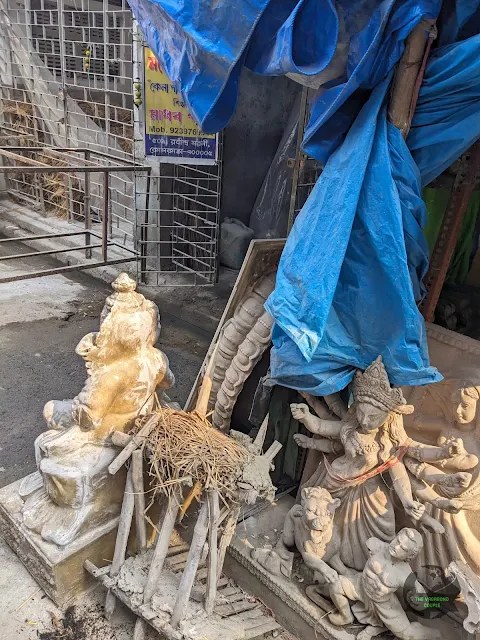
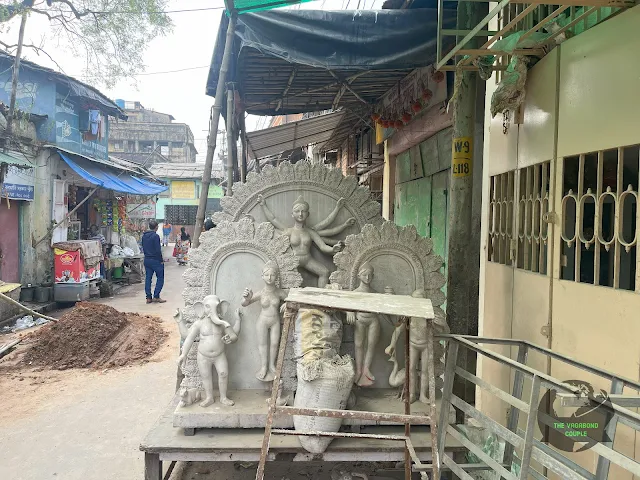 |
| Clay idols of Ma Durga and her children in progress at Kumartuli |
This isn't just craftsmanship; it's devotion poured into tangible form. Each idol, from the mighty Durga slaying the demon Mahishasura to the playful elephant god Ganesh, carries the hopes and prayers of countless devotees.
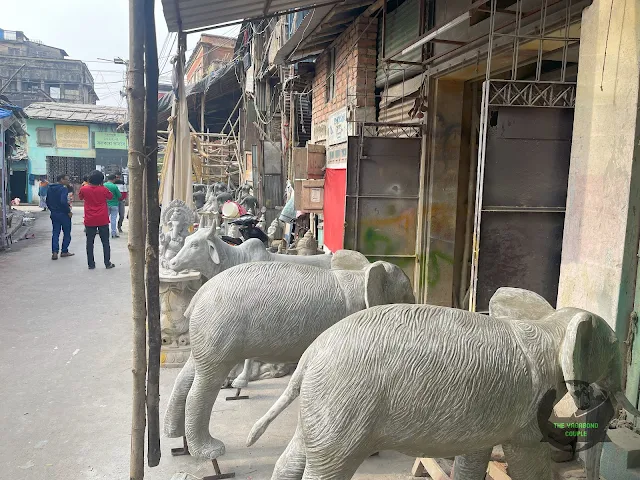 |
| Kumartuli |
In Kumartuli, the line between artist and devotee blurs, the air thick with the anticipation of the festival and the pride of bringing divine forms to life.
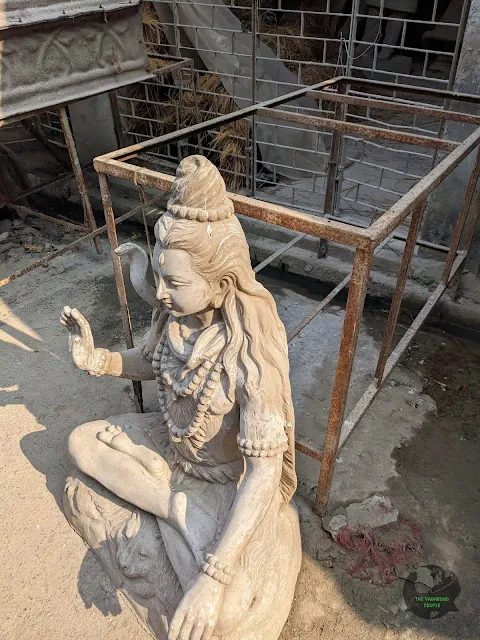 |
| Clay idol of Lord Shiva |
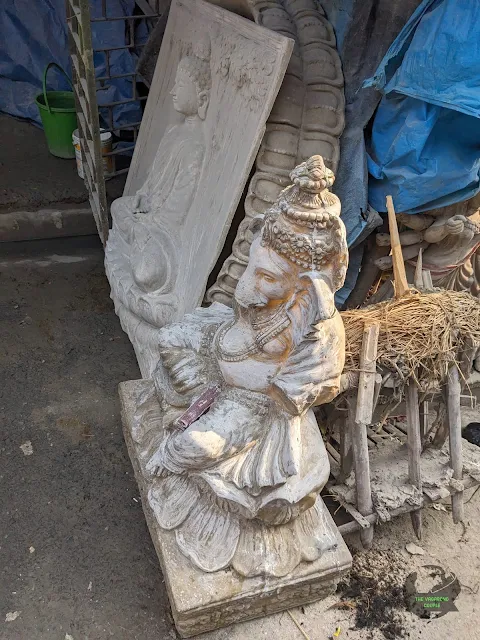 |
| Clay idol of Lord Ganesha next to the Buddha |
There is a global touch to Kumartuli, too, with a clay sculpture of Spiderman perched on a roof above Gandhi and Ma Durga on the ground!
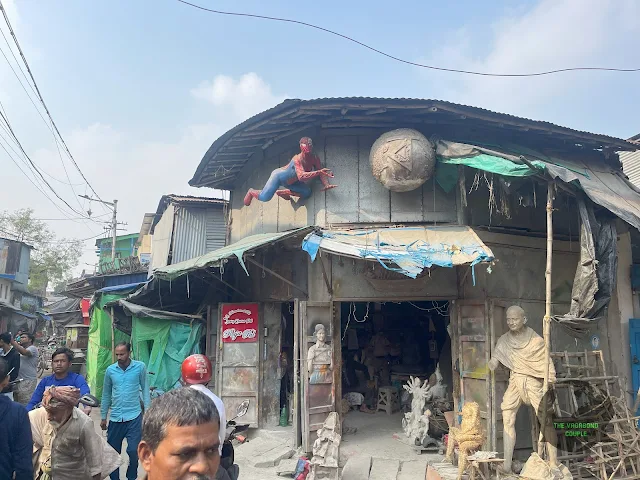 |
| Spiderman, Gandhi and Ma Durga clay sculptures among others at Kumartuli |
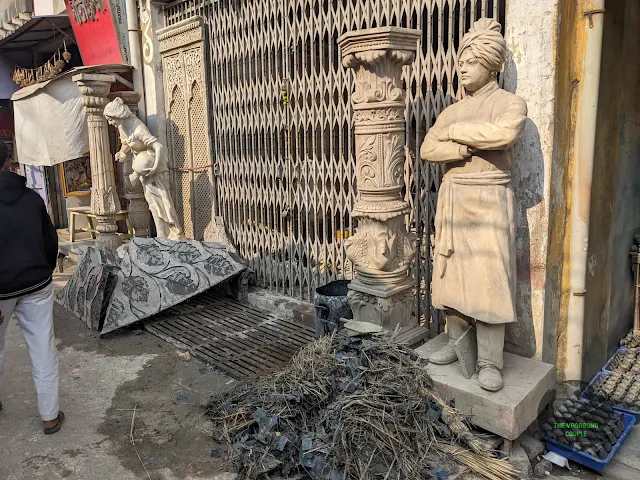 |
| Swami Vivekananda clay sculpture, Kumartuli |
 |
| Kumartuli |
Shree Niketan in Kumartuli is a typical 19th-century heritage abode in Kolkata. Its terracotta facade, embellished with intricate floral motifs and geometric patterns, whispers tales of bygone eras. Sunlight dances on the weathered brick, casting delicate shadows that intertwine with the vibrant hues of fresh clay peeking from neighboring workshops.
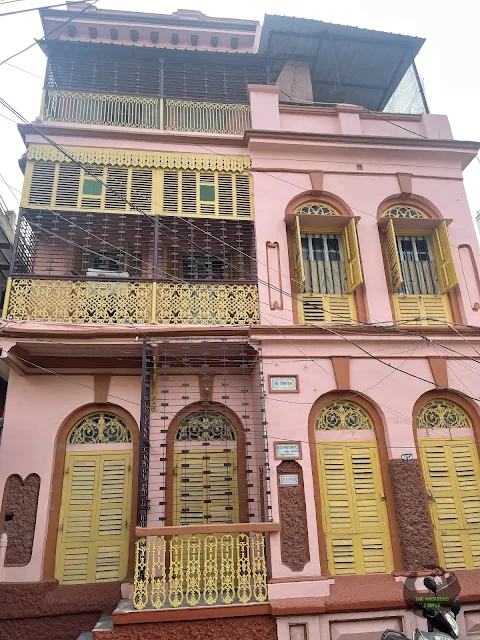 |
| Shree Niketan, Kumartuli |
Another heritage building near the intersection of Kumartuli Street and Gopeshwar Pal Street could use some maintenance! Unfortunately, numerous beautiful buildings in Kolkata, like this one, are in want of renovation and maintenance.
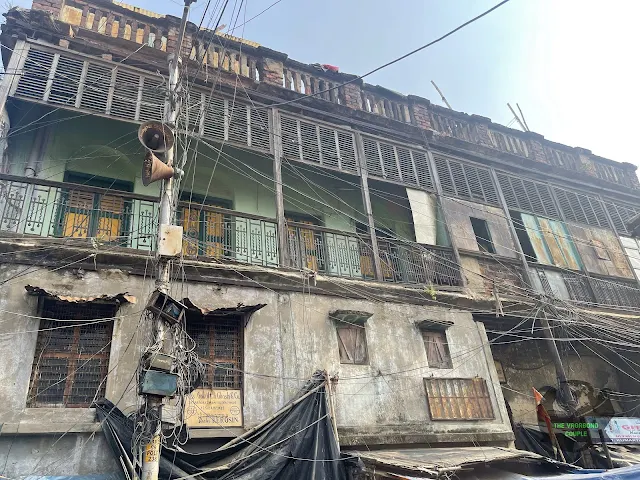 |
| Building near intersection of Kumartuli Street and Gopeshwar Pal Street |
Shobhabajar is a microcosm of Kolkata itself, a city where the past and present coexist in a vibrant embrace. It's a place where every step is a surprise, every sight a story, and every sound a melody.
Heading to the Baghbazar neighborhood, there is a palatial mansion on Banamali Sarkar Street that obviously has seen better days. Perhaps it is the house of a rich zamindar of yore. There is now a covered public urinal in front of the mansion's boundary wall.
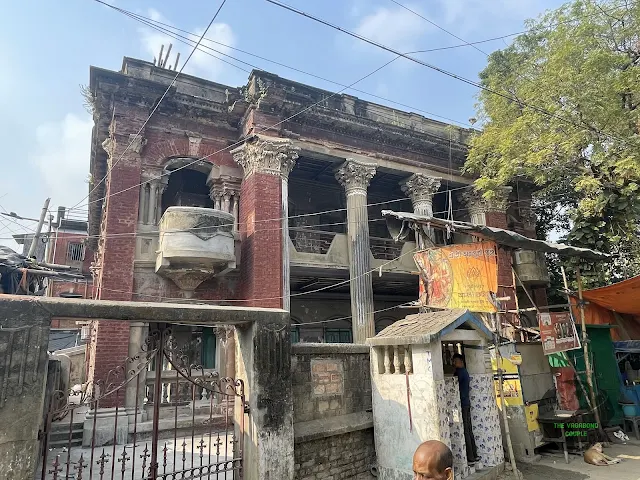 |
| Zamindar's House / Mansion in Kumartuli |
We visit Gokul Mitra's sprawling house in Baghbazar. While it no longer stands in its full grandeur, its legacy echoes through the streets and history books. Once a testament to the immense wealth and influence of this 18th-century merchant prince, the house reportedly occupied a staggering 56 bighas (22.5 acres) of land behind the Madan Mohan Temple.
 |
| Gokul Mitra's House |
Imagine opulent courtyards, spacious halls adorned with intricate carvings, and rooms overflowing with treasures accumulated through a life of shrewd business ventures, including salt trade and supplying provisions for the East India Company. Gokul Mitra's influence extended beyond his mansion, with his name forever linked to the construction of the Madan Mohan Temple, a landmark still revered today.
 |
| Gokul Mitra's House |
However, time, as it often does, eroded the Mitra family's fortune. Their lavish lifestyle faded, and the once-majestic house gradually gave way to smaller structures and changing landscapes. Today, only remnants and whispers of its former glory remain, scattered like puzzle pieces in the fabric of Baghbazar.
We stop for a drink of ice-cold Thums Up in bottles at a tiny shop at the intersection of Rabindra Sarani and Madanmohan Tala St. I grew up with Thums Up and have particular nostalgia about it. Thums Up isn't just a cola, it's an Indian icon. Born in 1977 to defy the departure of Coca-Cola, it roared onto the scene with a bolder taste and fiery spirit, mirroring the nation's own. Its cola kick is invigorating, a surge of caramel and spice that dances on the tongue, leaving a refreshing cool in its wake. But Thums Up is more than just a drink; it's a symbol of unapologetic confidence, a swagger in a bottle. It fuels adventure, cheers victories, and fuels the "masti" (fun) that runs through Indian veins. With its iconic red thunder logo and the slogan "Taste the thunder", it dares you to embrace life head-on, with a defiant thumbs-up. So, when you crack open a Thums Up, it's not just a thirst you quench, it's a taste of India's vibrant spirit, bottled for enjoyment!
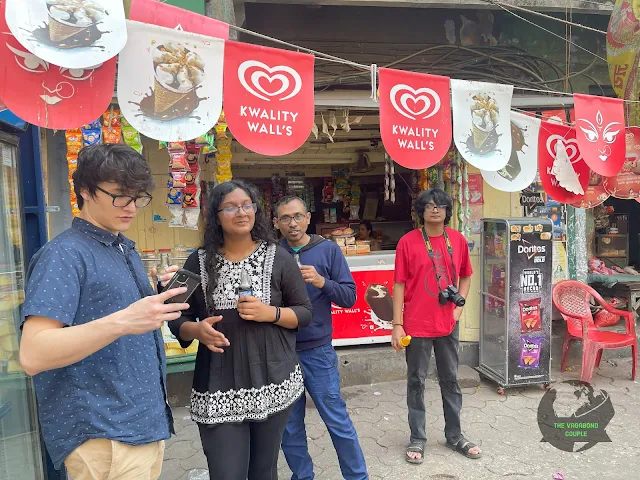 |
| Madanmohan Tala Street |
Heading to the British part of Kolkata, we drive past the Espalande neighborhood, the Calcutta monument (Shahid Minar), Eden Gardens cricket field etc. across the usual imposing British buildings on wide boulevards and gigantic green spaces found in any city with a colonial past, to go up Wellesley Place and stop at the gates of Rajbhavan on Government Pl. to take a picture. The sprawling estate is a majestic testament to the city's rich colonial past and present grandeur. Built in 1803 as Government House, this three-storied Neo-classical marvel served as the seat of British power in India. We, however, have limited interest in European colonial architecture of Kolkata, having seen numerous such British, Spanish and Portuguese constructs across the world, all of which have suffocated indigenous and far older and richer cultures.
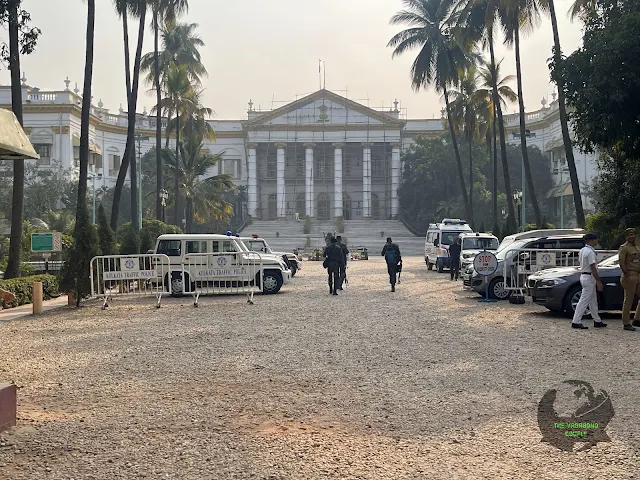 |
| Rajbhavan |
Today the Rajbhavan is the official residence of the Governor of West Bengal exuding an aura of power and prestige. Imagine a sprawling 7,800 square meter edifice enveloped by a lush 11-hectare compound. In a post-independence India, the official emblem featuring four Asiatic lions standing back to back, symbolizing power, courage, confidence and faith pervades the mansion's gates and walls. The wheel of the law, the Dharmachakra, is in the center of the abacus. "Satyameva Jayate" (सत्यमेव जयते) from the Mundaka Upanishad is boldly proclaimed under the Dharmachakra - "Truth alone triumphs".
 |
| India's State Emblem on a gate of Rajbhavan |
Six imposing gateways guard the periphery, each adorned with grand archways and mythical creatures like lions and sphinxes. Ornate Corinthian columns, intricate plasterwork, and gleaming marble floors whisper tales of a bygone era.
There is another one of the old pretty buildings of Kolkata at the intersection of Government Place and Wellesley Place across Rajbhavan.
 |
| Building at intersection of Government Place and Wellesley Place |
We drive around British Kolkata for a little while and head out to Prinsep Ghat. The word "Ghat" (ঘাট) is used in Bengali to mean a set of steps leading into the waters of a river. Standing sentinel on the banks of the Hooghly River, there is a memorial at Prinsep Ghat built in 1841. Its Palladian porch, a blend of Greek and Gothic influences, honors James Prinsep, the scholar who deciphered Ashoka's edicts.
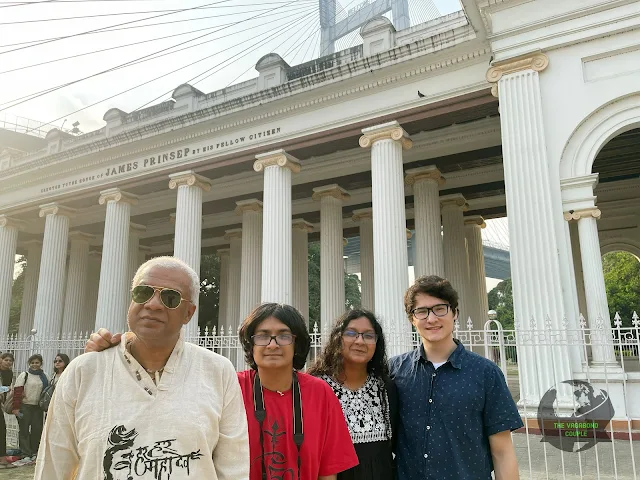 |
| Prinsep Ghat |
The Prinsep memorial's white façade reflects the golden rays of sunrise and bathes in the fiery hues of sunset while the majestic Vidyasagar Setu bridge ("2nd Hoogly Bridge") paints a picture of modern progress in the background.
 |
| Prinsep Ghat |
The steps of the ghat itself transcend their historical significance. The wharf is a haven for locals who stroll along the riverside, soak in the Ganges' calming embrace and watch boats traverse the water.
 |
| Prinsep Ghat |
On weekends, the air buzzes with laughter as families picnic on the grassy knolls, and the fragrance of street food mingles with the river breeze. Young couples capture their love against the backdrop of the bridge, while artists pour their souls onto canvases, immortalizing the ghat's timeless beauty. In the evenings, boat rides offer a unique perspective of the city, while the ghat transforms into a stage for cultural performances, echoing with music and dance.
 |
| Prinsep Ghat |
From tranquil mornings to vibrant evenings, Prinsep Ghat pulses with the rhythm of Kolkata.
We then head to St. Paul's Cathedral, the prominent 1847 Gothic church of Kolkata. However, it being Christmas day, the sheer size of the crowds on the streets precluded us from getting anywhere close to it. We managed to crawl by Victoria memorial on our way to Kolkata's Chinatown of Tangra.
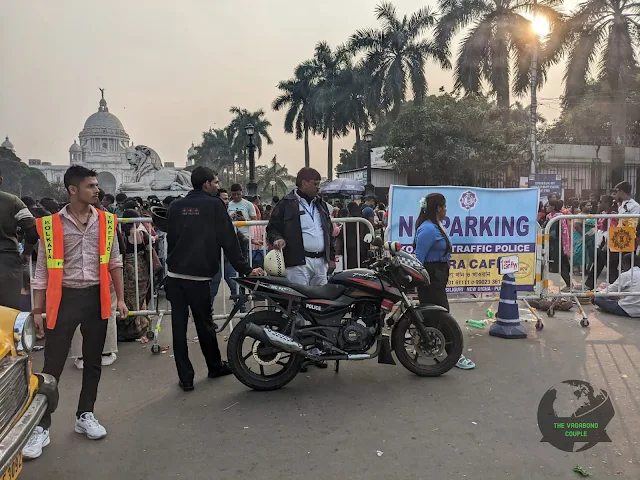 |
| Victoria Memorial |
The Victoria Memorial is a monument to Queen Victoria. It is a riot of white marble from Makrana, Rajasthan, adorned with intricate carvings and crowned by a majestic dome intended to impress with grandeur of the British Raj. Sprawling 64-acre gardens surround it. Among its numerous features designed to impress are a triumphal arch commemorating King Edward VII, Venetian windows whispering tales of distant lands and bronze statues of eminent personalities keeping watch over the city.
 |
| Victoria Memorial |
Elaborately decorated horse carriages offer rides around Maidan park outside Victoria Memorial, offering views of the memorial, Eden Gardens and other landmarks. Visitors can hire standard horse-drawn open-air carriages with seating for 2-4 people. Some may have canopies or curtains for sun protection. There are also smaller "Bhangas" for one or two people with more traditional covered designs with horsehair curtains. Some operators offer special "midnight rides" in carriages decorated with lights and flowers providing a romantic experience. Horse-drawn rickshaws ("tangas") are another option. These offer a cheaper and more unique alternative to carriages with similar routes and shorter rides. Or one can simply walk around to take in Kolkata's maidan in the most direct and personal way.
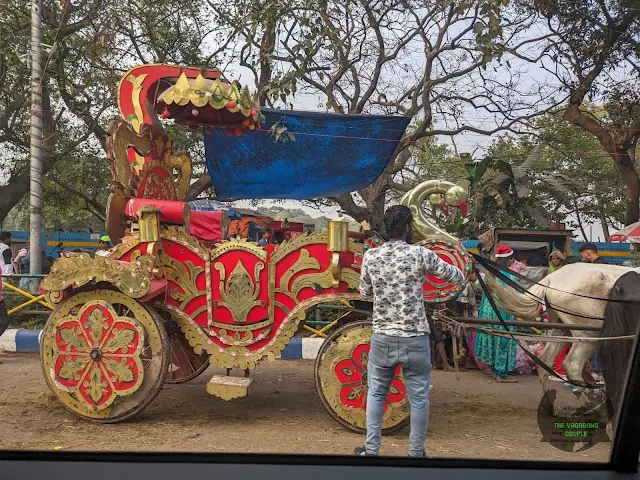
 |
| 2 and 4 person horse carriages at Victoria Memorial offer rides around the Kolkata Maidan |
We end the day with a sumptuous dinner of Indo-Chinese food at the place of its invention: Tangra, the Chinatown of Kolkata. That too in our favorite restaurant: Kim Ling. The first chapter of the history of Indo-Chinese cuisine unfolds in Kolkata of the late 18th century when Chinese immigrants, primarily Hakka people, began arriving in Kolkata (then Calcutta), settling down in areas like Tiretta Bazaar and Tangra establishing thriving communities. These early settlers brought their culinary traditions with them, but adapting them to the local ingredients and tastes, they laid the foundation for what would become the uniquely delicious Indo-Chinese cuisine. Over time, Indo-Chinese cuisine transcended Kolkata's borders, becoming a beloved part of Indian food culture throughout the country. Restaurants specializing in this unique blend emerged across India, adapting it further to regional preferences. Today, Indo-Chinese food is a global phenomenon enjoyed by millions and celebrated for its distinct flavors, affordability, and nostalgic charm.
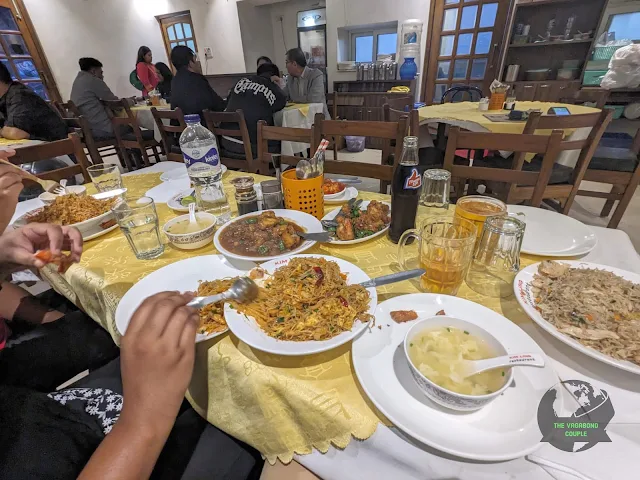 |
| Dinner Spread at Kim Ling, Tangra |
Kolkata, the capital of the Indian state of West Bengal, is a vibrant and culturally rich city that seamlessly blends its colonial past with a bustling present. Formerly known as Calcutta, it stands as a testament to India's historical and architectural diversity. The city is renowned for its grand colonial-era buildings, including the iconic Victoria Memorial, Howrah Bridge, and Marble Palace. Kolkata is a hub of arts and literature, with numerous theaters, galleries, and literary festivals. It also boasts a thriving street food culture, offering delectable treats like rolls (now called "Kathi rolls") and phuchka (Bengali variant of pani puri/golgappa). The River Hooghly flows through the city, enhancing its picturesque charm. Kolkata is home to the annual Durga Puja festival, one of the largest and most celebrated events in the country, showcasing the city's deep-rooted traditions and lively spirit.
Kolkata is a city that beckons you to wander, to explore, to get lost in its labyrinthine lanes and emerge with a heart full of memories and a soul enriched by the experience.
On to our next destination: The Taj Mahal, Agra!

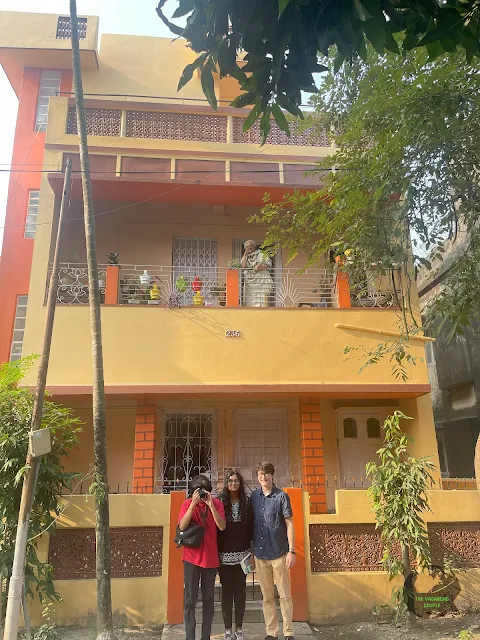


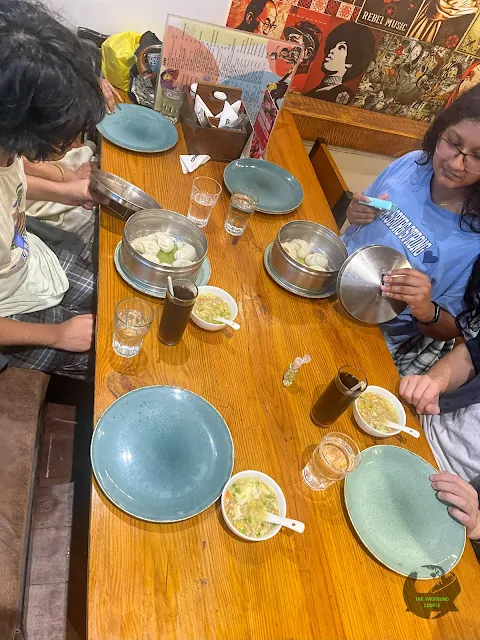
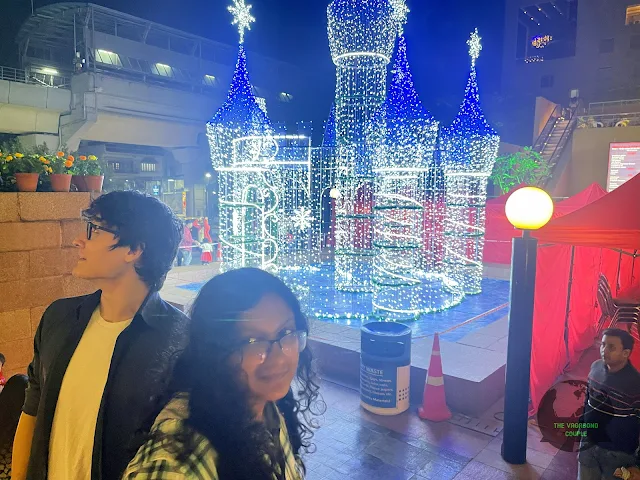
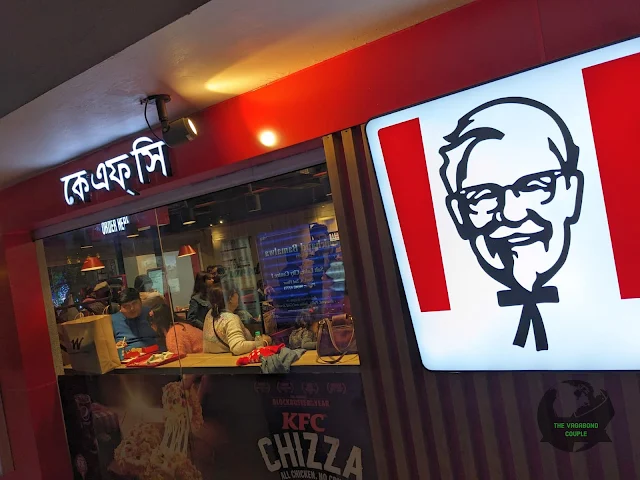


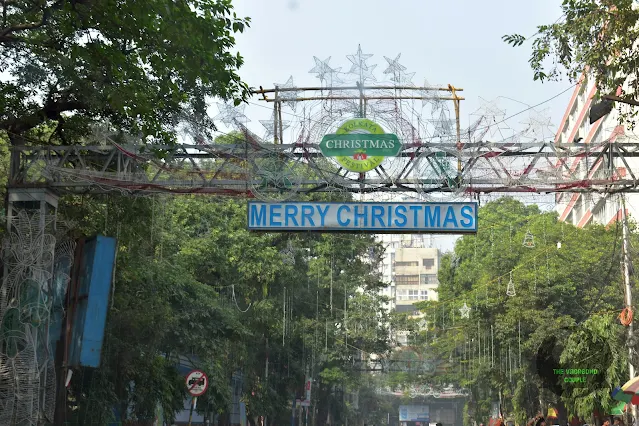

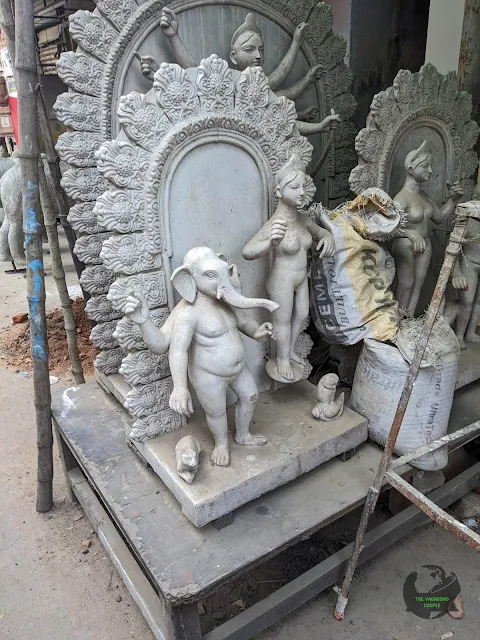

0 comments